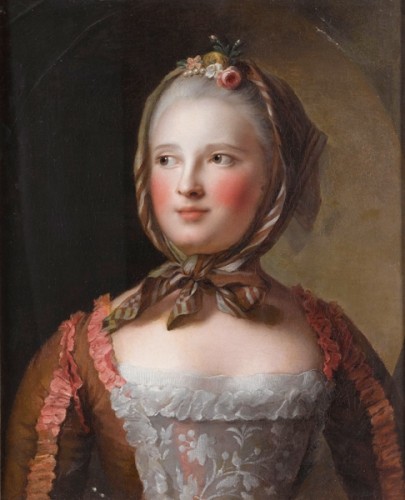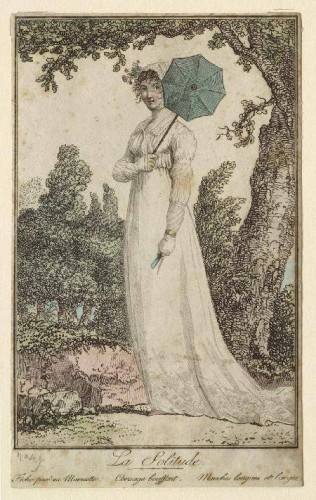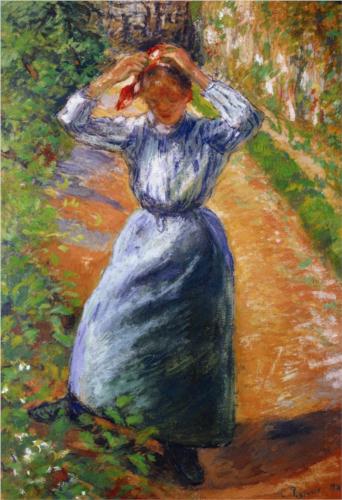A few weeks ago, when I wrote about the difference between kerchiefs, buffonts & fichus, I posted a picture of a ‘fichu en marmotte.’

Gallerie des Modes et Costumes Français. Jeune Dame coiffee d’un Bonnet rond avec un fichu en marmotte, un Ruban en rosette, une Polonoise et un mantelet blanc, 1788
We had a bit of discussion about what a fichu en marmotte actually meant, and why it was called a marmotte, and where the term might have come from. I was pretty sure that a marmotte actually referred to a marmot, but did the headscarf and the rodent have anything to do with each other, and why?
Being me, I kept wondering about marmots and marmottes, and kept digging and researching, and I am pleased to say I have figured out why a fichu en marmotte is en marmotte.
It turns out that fichus en marmotte are named after marmots, in a roundabout way.
In the 17th & 18th century peasants from the alpine region of Savoy would train marmots and dance with them as street entertainment.

Petits metiers, cris de Paris (Street vendors of Paris), Claude-Louis Desrais (1746-1816) (Nanette, the hurdy-gurdy Savoyarde and the dancing marmot are shown in the last two sections)
Yes. You read that right. 18th century. Streets of Paris. Dancing groundhogs. DANCING GROUNDHOGS.

Savoyarde with a marmotte, after Watteau, François Boucher, Wikipedia
Basically they were a precursor to the more-famous organ grinders with monkeys of the 19th century. Only, y’know, with GROUNDHOGS.
Right. So why were alpine marmots dancing in Paris anyway, and what does this have to do with headscarfs?
Mid-17th century Savoy had a strong link to France, as the Duchess of Savoy, Christine Marie of France, was Louis XIII’s sister. From 1637 onwards she was regent of Savoy, and the Duchy was effectively a satellite state of France. The close ties between the two countries saw her son marry two French princesses, and Savoyarde peasants, including the dancing-marmot street entertainers, travelled to Paris to find work during the economic depressions that plagued Savoy. The dancing marmots were so iconic that Savoyarde peasants were soon called ‘marmottes‘ (which, if considered from a modern perspective, is horrifically un-PC.)

Jean-Honore Fragonard (1732—1806), Jeune Fille à la Marmotte (The Savoyarde organ grinder), Portland Art Museum, USA
The most notable feature of the dress of Savoyarde peasant women was a kerchief tied beneath the chin. When pastoral fashions became all the rage in mid-18th century France, the marmotte’s headscarf, along with the shepherdesses-broad brimmed hat, were adopted by the upper classes. The broad brimmed hat was literally called a shepherdess (bergere), and the headscarf, in its turn, was called after the people it was taken from: the marmottes. So a ‘marmotte‘ is simply a kerchief tied under the chin in the style of the Savoy peasants, the marmottes.

Une Savoyarde, Noël Halle, 1757
The first depictions of upper-class French women in marmottes at the end of the 1730s show them dressed as Savoyarde, organ/marmot box and all – a literal adaptation of the costume that was possibly worn as fancy dress. By the 1740s Savoyarde fashions had amalgamated with mainstream elegant peasant-wear, and were no longer just dress-ups.

Countess Christina Margareta Törnflycht Augusta, Countess Wrede-Sparre of Sundby (1714-1780) dressed as a marmotte, 1739, Gustaf Lundberg, sold at auction
When marmottes first became fashionable they were strongly linked to pastoralism, and so projected an air of bucolic innocence and alpine purity. The most proper of women could dress as marmottes, or in the marmotte fashion, without censure.
In 1751, the dauphine, Marie-Josèphe of Saxony (she of the loveliest MIL/DIL story, and one of my favourite pretty, pretty princesses), was painted in a private portrait which she gave to a friend dressed in Savoyarde fashion. The informal portrait in fashionable, rather than court, dress, represents a major departure in etiquette for a French dauphine, but Marie-Josèphe was pregnant with the heir to the throne, was a court favourite, and was known for her virtue and impeccable character. Her position was quite secure, so the portrait was not a risk (this is in comparison to informal portraits of her daughter-in-law, Marie-Antoinette, executed when she was in a much less secure position), and her chic alpine-inspired peasant look simply accentuated her morality.

Marie-Josèphe of Saxony in the Savoyarde style, 1750-51, Jean-Marc Nattier. Palace of Versailles.
By the end of the 1750s, morality and marmottes were fast parting ways. Savoyarde peasant women in Paris were turning to an occupation somewhat older and more profitable than street entertainment with dancing marmots, and their headdscarfs became a signal of their new profession.
Rather than abandoning the marmotte once it lost its implications of pastoral purity, the decadent French court embraced its new connotations of sauciness. The scarf went from bucolic simplicity to innocence lost – with a thoroughly modern wink and nod. Rather than advertising virtue, the later 18th century marmotte (and its many elaborations) advertised fashionable daring.
By the end of the 18th century the marmotte as a fashion item had probably lost both meanings – it claimed neither rural simplicity, nor risque worldliness. Marmottes, however, remained fashionable throughout the early 19th century as simple, practical but still moddish headgear: the Regency answer to the bad hair day.

Modes et Manières No. 49 : La Solitude (Fichu pose en Marmotte. Corsage bouffant. Manches longues et larges), Debucourt, Philibert-Louis, 1755-1832, 1801
Marmottes were so ubiquitous and useful that it was used as a word for headscarf at least into the 20th century in certain regions of France. Marmotte also became a synonym for ‘winding’ particularly around the head (obviously because the kerchief is wound around the head).
The Savoyarde musicians, with or without marmots, also continued past the 18th century. This charming early 19th century fabric shows a street musician, still in her characteristic headscarf, entertaining a young family with a dancing animal:

Petite Savoyard or La Reconciliation Date- 1815—25 Culture- French (Nantes) or (Rouen, possibly) Medium- Cotton, Met
In this 1860s cartoon, the street musician with his rodent (though the marmot has become a mouse) is very much the symbol of Savoy. The woman asks “Little Savoyarde, what have you done with your white mouse?” and the musician replies “He’s here madame, but now he’s French so he’s taken on the national colours”. The cartoon is a commentary on France’s annexation of Savoy in 1860 as part of the Treaty of Turin.
In addition to being a fascinating early example of alpine-inspired fashion trends, the Savoyarde movement added one further word to the French vocabulary. Marmotte was also used to describe a rectangular travelling case that resembled the boxes that the original Savoyarde musicians used to carry their marmots in. The term seems to have added to a bit of artistic miscommunication, which added to the confusion of attempting to research this term.
So what happened? Well, Watteau produced a number of sketches depicting Savoyarde musicians in the early 18th century. Some, like this sketch of a female Savoyarde in her scarf, do not include a marmot, though the box with a breathing hole is clearly for carrying a small animal.
Some of the sketches clearly showed the marmot on top of the box. Usually called ‘Savoyarde avec sa marmotte‘ (Savoyarde with his marmot), the sketches were widely reproduced as engravings and by other artists. Boucher copied one (his version is the second image in this post), and he presumably had actually seen a Savoyarde and knew what a marmotte actually was, so included a marmot in his version. The English artists who copied Boucher copying Watteau were unlikely to have seen a marmot, were not privy to this information, and assumed that the marmotte was solely the box itself, and interpreted the dark lump on the box as part of the musicians sleeves, rather than seeing it as a small furry animal. Thus we have museums that translate Watteau’s ‘Savoyarde avec sa marmotte‘ as ‘Savoyarde with his box’ or ‘Savoyarde with his travelling case’, completely ignoring the marmot sitting on the box!
Sources:








So fascinating! And particularly dear to me. I can now proudly claim that my bad hair day headscarves are actually meant to go with my nickname!
I can now proudly claim that my bad hair day headscarves are actually meant to go with my nickname! 
Although I do not tie them under the chin…
Oh don’t worry, other tie variants are also included under the term ‘marmotte’. You still qualify!
Right; Google search gives me at least modern images with a similar style to that I use…
I imagine you dressed as Rosie the Rivetter and her iconic and practical headscarf!
I LOVE what I learn from reading your blog! Fascinating history, and in all honesty, I will be picturing dancing groundhogs for the rest of the day!
Thanks Joelle! I was really pleased by how this research went (and yes, have been having dancing groundhog visions myself!)
enjoyed this – fantastic Art finds. I had never equated marmots with groundhogs! let alone linked to headwear. The whole sequence of association seems so logical.
Thank you
Oh my word that is interesting! Such a journey of meaning change. love how language evolves alongside fashion, history and politics.
Yes yes! And I adored getting my linguistics MA for that very reason. (And your comments for being very witty!) I think I like clothing history for the same reason I like language history: How does a culture outwardly show itself?
What a great essay! Not only did you give us a good chunk of fashion history, but you’ve given us a little slice of French cultural history too! Brava!
Thank you Cathy! I find that fashion and culture are often inextricably linked.
Fascinating! There clearly seems to have been a trend for naming things after rodents – I’m thinking about the dormeuse cap and also a cravat worn by one of the Incroyables that is described as “hare’s ears”….
I wonder if this started the rodent trend? Or, if, by the time the name ‘marmottes’ was adopted for the scarves, the fashionable Parisienne even equated it with a rodent instead of a Savoyarde?
I am enchanted! My favourite terminology post so far. The marmot thing had been niggling with me, too, and I am delighted to have it all explained so beautifully.
But I’m with you – what were they thinking? Dancing ground-hogs??? I can’t believe that the poor little things would have been that good at it, unlike dogs, for instance, which seem to be perfectly happy to dance everything from a waltz to a salsa these days.
Very, very funny, and absolutely fascinating.
That is so fascinating! A dancing monkey is one thing, but I can’t imagine training a groundhog to dance. I find the evolution of the morality associated with the fichu very interesting, too.
well, I am lost for words…..the things I am learning.
That was fascinating – thanks for sharing!
Dear Leimomi,
What a super-duper research essay. Loved every bit.
Very best,
Natalie
Thanks for doing all this research and sharing it with us! I love reading this kind of thing and the idea of dancing groundhogs is just too great!
Wikipedia says that the “marmot” is actually something also known as a ground squirrel, though (confusingly) groundhogs are also known as marmots:
http://en.wikipedia.org/wiki/Marmot
A groundhog looks like nothing so much as an American-style football with fur. On the other hand, something that looks like this would be somewhat entertaining to watch dancing:
http://en.wikipedia.org/wiki/File:Marmota_flaviventris_%28Yellow_Bellied_Marmot%29,_Yosemite_NP_-_Diliff.jpg
Yes, marmots are known as ground squirrels, or groundhogs.
It seems there are fifteen species of marmot. The dancing variety is probably Marmota Marmota, given the location. Though I might have plumped for the Yellow Bellied Marmot as the one most likely to take instructions, or the Olympic Marmot as the one most likely to be good at it!
I believe it is; I have a book about animals living in the mountains (purchased because of marmots, of course), and it did mention the training of marmots and the marmot in focus was Marmota marmota.
There was also an interesting tidbit about marmots having been released in the Pyrenees as food for the bears, but the marmots actually live in higher levels than bears, so they live and prosper.
The relation is simpler to understand in Czech, where there is a two-name naming going on in biology similar to the Latin system (but hardly equivalent), so both marmots and groundhogs are “sviÅ¡Å¥”: sviÅ¡Å¥ horský (mountain marmot) and sviÅ¡Å¥ lesnà (forest marmot).
Oooh…you have a book about the training of marmots!?! All I could find were old French encyclopedias that barely mentioned it, and the paintings/sketches I found, pieced together with histories of Savoy. Very little on the marmots themselves, and what the dancing looked like.
Sorry for the late reply – I did not notice it until now! It’s not about the training of marmots, it’s a lavishly illustrated book on several types of animals living in the mountains (it’s from a series, my sister has rivers). In a section of interesting tidbits, it mentions that marmots were trained – I believe it just says something like likening it to the practice of trained bears on fairs, or some such. So it’s not much more than you’ve got, but it’s another source that mentions it.
Thank you so much for this! I should go back and link to you in the relevant GdM plate(s?).